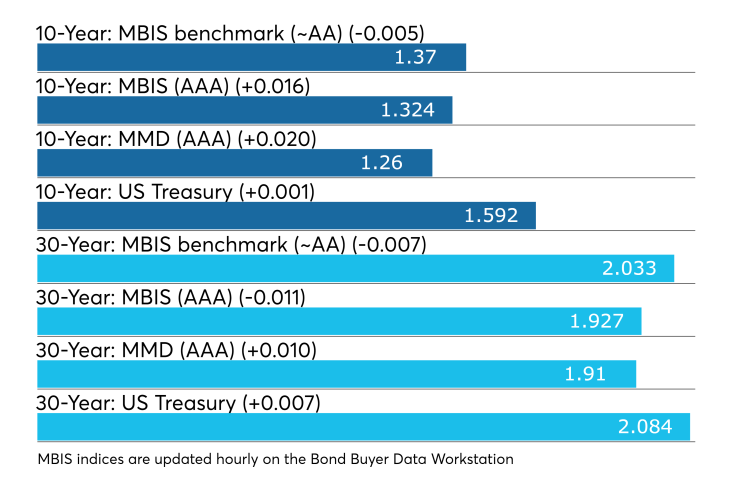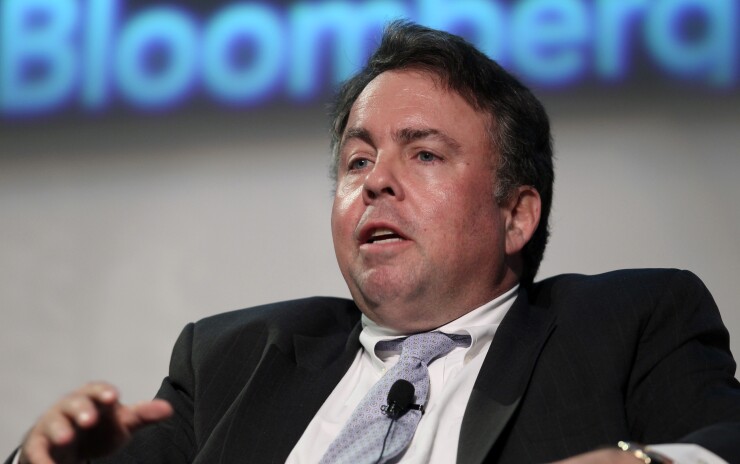
It was a double-dip for Houston as it returned to the municipal market on Thursday with a second helping of securities. Long Beach, California, competitively sold $450 million of bonds to BofA Securities.
Primary market
Ramirez & Co. priced Houston's (Aa3/AA/NR) $494 million of public improvement refunding bonds on Thursday.
The deal consists of $255.615 million of Series 2019A refunding bonds, $214.95 million of Series 2016B taxables and $23.27 million of Series 2019C forward delivery refunding bonds.
Barclays, Wells Fargo Securities, Frost Bank, Hutchinson, Shockey Erley and Jefferies are co-managers. Masterson Advisors and the RSI Group are the municipal advisors. Bracewell and Baker Williams Matthiesen are bond counsel. Proceeds will refund certain of the city’s outstanding public improvement bonds and general obligation commercial paper notes.
It was the city's second trip to the primary market this week. On Tuesday, Citigroup priced Houston's $771 million of combined utility system first lien revenue refunding bonds.
"With most of this weeks' supply stemming from Texas, and more specifically Houston, the trend has been substantial the past four weeks or so," one Texas trader said. "The Aug. 15 pay dates were enormous with a massive $11 billion-plus in net negative supply and I don’t believe that all that money had been put to work. There will be some lagging demand for Texas paper and keep in mind that the state offers some of the best value nationally."
BofA Securities priced the Kentucky Municipal Power Agency’s (Baa1/BBB/NR) $133.11 million of Series 2019A and forward delivery Series 2020A power system revenue refunding bonds for the Prairie State project.
Morgan Stanley priced the Northeast Ohio Regional Sewer District’s (Aa1/AA/NR) $245.505 million of Series 2019 wastewater improvement refunding revenue bonds.
Goldman Sachs received the written award on San Antonio's (Aa1/AA/AA+) $114.69 million of New Series of 2019 electric and gas systems revenue refunding bonds.
In the competitive arena, Long Beach, California (Aa2/AA-/NR), sold $450 million of general obligation bonds in two offerings.
BofA Securities won the $300 million of Series B Election of 2016 GOs with a true interest cost of 2.873%. Morgan Stanley won the $150 million of Series F Election of 2008 GOs with a TIC of 2.7791%.
Keygent is the financial advisor; Hawkins Delafield is the bond counsel. Proceeds will be used to finance school facilities projects.
Thursday’s bond sales
Wild ride for bonds
The past couple of weeks have been breathtaking for bond investors and observers of the bond market, John Mousseau, president and CEO at Cumberland Advisors, said in a recent report, noting the yield on the 30-year Treasury bond was near a record low.
"With a little more than two weeks gone in August, we have seen the 10-year drop 47 basis points and the 30-year 53 basis points," he said. "This is more movement in two weeks than we sometimes see in six months."
"Most pundits are using the inversion of the yield curve as a forecast of a slowdown. But as we have noted in other pieces, economic slowdowns are far from synchronous with inversions. Growth continued for a year and a half after the yield curve inverted in 2006,” according to Mousseau. "This is a bond market that has been buffeted by a number of factors that are not U.S.-related."

As far as managing bond assets go, Mosseau said they continue to manage Cumberland total-return bond assets in a barbell method, using shorter-term securities for liquidity and longer-term bonds for yields, with what have been non-Treasury securities in the taxable world and longer tax-free bonds in munis.
"Indeed, with the fast rush down in Treasury yields, longer-dated munis, though at historical lows, offer value when you can get 3% higher grade in a world where long Treasuries are at 2%," he said. "We will take our chances with 160% yield ratios, knowing that defensiveness is built into the cheapness."
He added that the front end of the muni curve is very expensive relative to Treasuries, so even with a barbell and very low nominal yields, it’s been prudent to have exposure to the longer end of the market.
"The barbell strategy works less well when the Fed is at the end of a hiking cycle. We don’t believe the Fed is done yet."
BB indexes drift lower
In the week ended Aug. 22, the weekly average yield to maturity of the Bond Buyer Municipal Bond Index, which is based on 40 long-term bond prices fell three basis points to 3.54% from 3.57% the previous week.
The Bond Buyer's 20-bond GO Index of 20-year general obligation yields was lower by three basis points to 3.07% from 3.10% the week before. It is at its lowest level since Sept. 29, 2016, when it was at 3.06%. The 11-bond GO Index of higher-grade 11-year GOs dropped three basis points to 2.61% from 2.64% the previous week. It is at its lowest level since Sept. 22, 2016, when it was at 2.56%. The Bond Buyer's Revenue Bond Index slipped three basis points to 3.55% from 3.58% the week before. It is at its lowest level since Nov. 3, 2016, when it was at 3.44%.
The yield on the U.S. Treasury's 10-year increased to 1.62% from 1.53% and the 30-year Treasury's descended to 2.11% from 1.98%.
Secondary market
Munis were stronger in late trade on the
On Refinitiv Municipal Market Data’s AAA benchmark scale, the 10-year muni GO yield rose two basis points to 1.26% and the 30-year yield increased one basis point to 1.91%.
“Municipal bonds are continuing their mid-August trend of lower volumes and little price action,” ICE Data Services said in a Thursday market comment. ”Investment-grade yields are up 1 to 1.5 basis points today while high-yield is generally holding its own.”
The 10-year muni-to-Treasury ratio was calculated at 78.3% while the 30-year muni-to-Treasury ratio stood at 91.2%, according to MMD.
Treasuries were weaker as stocks traded mixed. The Treasury three-month was yielding 1.992%, the two-year was yielding 1.585%, the five-year was yielding 1.480%, the 10-year was yielding 1.592% and the 30-year was yielding 2.084%.

Previous session's activity
The MSRB reported 33,812 trades Wednesday on volume of $20.31 billion. The 30-day average trade summary showed on a par amount basis of $11.33 million that customers bought $5.87 million, customers sold $3.37 million and interdealer trades totaled $2.10 million.
Texas, California and New York were most traded, with the Lone Star State taking 27.49% of the market, the Golden State taking 13.199% and the Empire State taking 9.995%.
The most actively traded security was the Texas TRANs 4s of 2020, which traded 252 times on volume of $673.47 million.
Interest in green bonds growing
Interest in sustainable financing and green bonds is growing in the U.S. and around the world, Janney said in a Thursday market comment.
“The U.S. SIF Foundation's most recent biennial report indicates that sustainable, responsible, and impact investing assets reached $12 trillion in early 2018, up 38% since 2016. Institutional investors manage the majority ($8.6 trillion), with U.S. public pension funds leading the way at 54%, followed by insurance firms at 37%, education-related organizations at 6%, and foundations & labor organizations at 1%. The RBC/BlueBay/P&I survey found equities are no longer the primary focus of ESG considerations, with 60% of respondents incorporating the factors into their fixed-income portfolios.”
Janney said that while the U.S. municipal bond market was slow in coming out of the gate, issuance is starting to pick up.
“Admittedly, muni bonds are still a small part, but there are a few green bond transactions sprouting up in the coming weeks: Moody’s recently assigned a new rating of A3 stable to The Conservation Fund, Virginia, issuing $150 million of taxable green bonds in early September. Next week, the Port of Los Angeles, California, (Harbor Department; Aa2/AA/AA) will be selling $215 million of bonds, with a small $16 million of that in green bonds.”
Muni money market funds see outflows
Tax-exempt municipal money market fund assets lost $261.9 million, lowering total net assets to $135.59 billion in the week ended Aug. 19, according to the Money Fund Report, a publication of Informa Financial Intelligence.

The average seven-day simple yield for the 191 tax-free and municipal money-market funds rose to 0.96% from 0.94% in the previous week.
Taxable money-fund assets increased $17.37 billion in the week ended Aug. 20, bringing total net assets to $3.192 trillion, the tenth consecutive week that the taxable total has reached or exceeded $3 trillion. The average, seven-day simple yield for the 807 taxable reporting funds declined to 1.79% from 1.80% the prior week.
Overall, the combined total net assets of the 998 reporting money funds rose $17.11 billion to $3.328 trillion in the week ended Aug. 20.
Treasury auctions announced
The Treasury Department announced these auctions:
- $32 billion seven-year notes selling on Aug. 29;
- $41 billion five-year notes selling on Aug. 28;
- $40 billion two-year notes selling on Aug. 27;
- $18 billion one-year 11-month floating rate notes selling on Aug. 28;
- $42 billion 182-day bills selling on Aug. 26; and
- $45 billion 92-day bills selling on Aug. 26.
Treasury auctions bills
The Treasury Department Thursday auctioned $55 billion of four-week bills at a 2.060% high yield, a price of 99.839778. The coupon equivalent was 2.098%. The bid-to-cover ratio was 2.59. Tenders at the high rate were allotted 12.87%. The median rate was 2.020%. The low rate was 1.980%.
Treasury also auctioned $40 billion of eight-week bills at a 1.985% high yield, a price of 99.691222. The coupon equivalent was 2.024%. The bid-to-cover ratio was 2.86. Tenders at the high rate were allotted 88.24%. The median rate was 1.950%. The low rate was 1.920%.
Treasury sells TIPS
The Treasury Department Thursday sold $7 billion of inflation-indexed 29-year six-month bonds at a 0.501% high yield, an adjusted price of 115.685230, with a 1% coupon. The bid-to-cover ratio was 2.70.
Tenders at the market-clearing yield were allotted 48.33%. Among competitive tenders, the median yield was 0.460% and the low yield was 0.088%, Treasury said.
Gary E. Siegel contributed to this report.
Data appearing in this article from Municipal Bond Information Services, including the MBIS municipal bond index, is available on The Bond Buyer Data Workstation.





